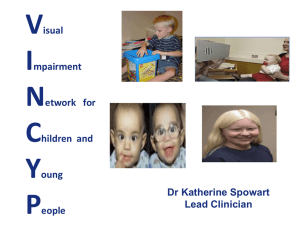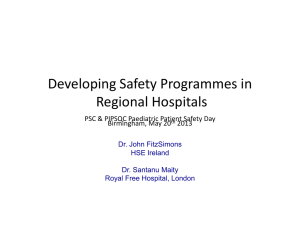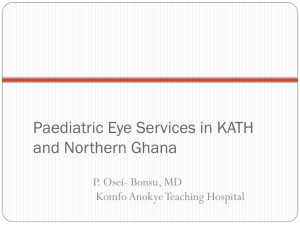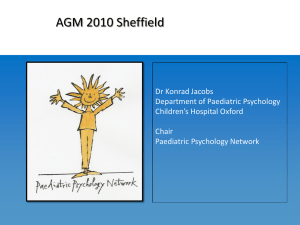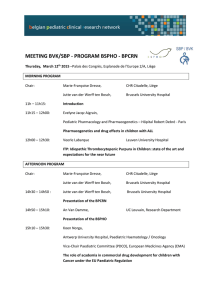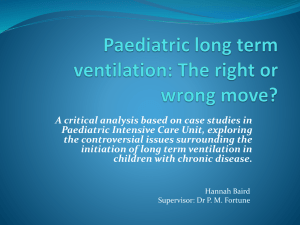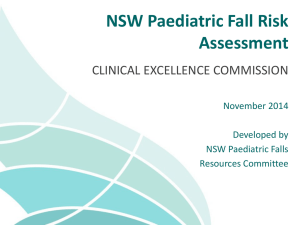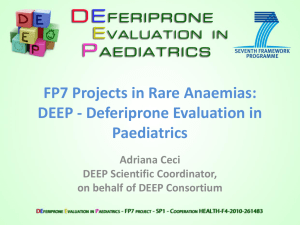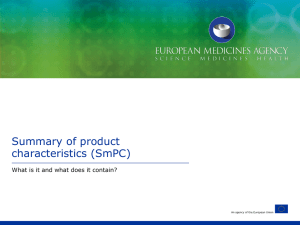New SmPC guidance for paediatric information
advertisement
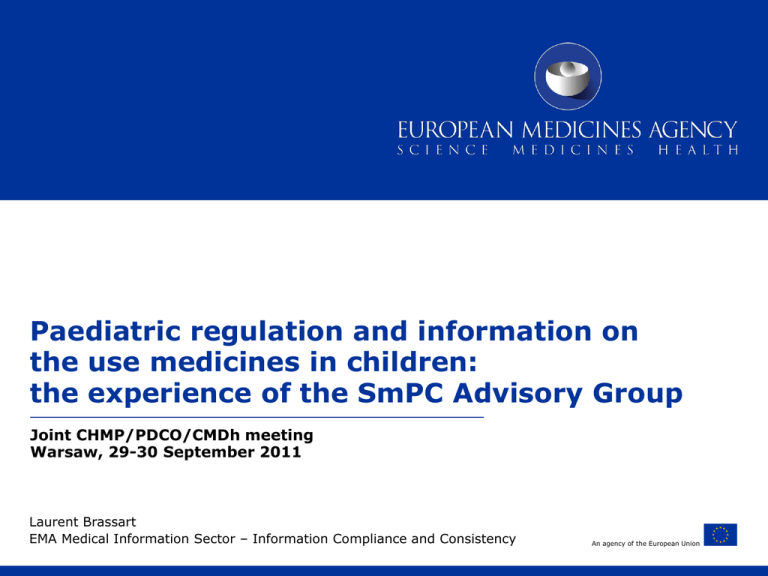
Paediatric regulation and information on the use medicines in children: the experience of the SmPC Advisory Group Joint CHMP/PDCO/CMDh meeting Warsaw, 29-30 September 2011 Laurent Brassart EMA Medical Information Sector – Information Compliance and Consistency An agency of the European Union http://eudrasmpc.eudra.org/ SmPC Advisory Group members Jane Ahlqvist (PhVWP) Adriana Ceci (PDCO) Maria Fernandez Cortizo (PDCO) Truus Janse-de Hoog (CMD(h)) Birka Lehmann (PDCO) Rita Offermann (QRD) Magda Pedro (PhVWP) Patrick Salmon (CHMP) Anna Wachnik-Święcicka (QRD) Dominique Westphal (CMD(h), QRD) Jane Woolley (PhVWP) Klaus Menges (BfArM) Laurent Brassart (EMA-MIS) Amandine Chomette (EMA - P-MI-PIQ) Margot Martin (EMA - H-SE-AIV) Margaux Philippe (EMA - H-SE-ONC) Andrea Taft (EMA - H-SE-ECV) Webinars on SmPC: 5/year Upcoming: -Pharmaceutical information and pharmacogenomics 07/10/11 -Posology and special populations: 23/11/11 1 March2010-2011: >5400 visits >100 participants/webinar 50 written Q&As http://eudrasmpc.eudra.org/ SmPC Advisory Group members Jane Ahlqvist (PhVWP) Adriana Ceci (PDCO) Maria Fernandez Cortizo (PDCO) Truus Janse-de Hoog (CMD(h)) Birka Lehmann (PDCO) Rita Offermann (QRD) Magda Pedro (PhVWP) Patrick Salmon (CHMP) Anna Wachnik-Święcicka (QRD) Dominique Westphal (CMD(h), QRD) Jane Woolley (PhVWP) Klaus Menges (BfArM) Laurent Brassart (EMA-MIS) Amandine Chomette (EMA - P-MI-PIQ) Margot Martin (EMA - H-SE-AIV) Margaux Philippe (EMA - H-SE-ONC) Andrea Taft (EMA - H-SE-ECV) Webinars on SmPC: 5/year Upcoming: -Pharmaceutical information and pharmacogenomics -Posology, paediatric populations, elderly 2 07/10/11 23/11/11 Cost-effective tools to facilitate harmonised evaluation and review of SmPC within the regulatory network. SmPC Advisory Group - Overall experience • Upcoming SmPC Advisory Group 1-year Activity Report • SmPC information on paediatric population is improving • Progress is also observed for the implementation of the principles of the SmPC guideline regarding section 4.8 Summary of safety profile + Single table + Description of selected adverse reaction + Paediatric population + Other special population • Trend for increasing efficacy, safety or PK data, sometimes without clear recommendation, which may dilute important SmPC information for the safe and effective use of medicinal product (SmPC or EPAR?) 3 SmPC and paediatric information • Regulation (EC) no 1901/2006 – To improve the information available on the use of medicinal products in the various paediatric populations. • Because the reward is for conducting studies in the paediatric population and not for demonstrating that a product is safe and effective in the paediatric population, the reward should be granted even when a paediatric indication is not authorised. However, to improve the information available on the use of medicinal products in the paediatric population, relevant information on use in paediatric populations should be included in authorised product information. • Revision 2 of the SmPC guideline (September 2009) – http://eudrasmpc.eudra.org/: Dedicated Paediatrics presentation 4 Query & Answer on paediatric information • 25% of queries related to paediatric information • Many other paediatric queries addressed outside the Q&A system • Various scopes: – Information on waiver and deferral, – 4.1 and age group, – Result of paediatric studies in 5.1 – Safety information in paediatric population – Information on peri- or post-natal studies in 5.3 5 Paediatric information in SmPC of new active substances (CAP – Oct. 2010 to Sept. 2011) 6 Some observations • 4.1: states in which age groups the product is indicated in 19 of 23 products. – Products not stating the age groups: products indicated in adult cancer and one H5N1 vacc. • 4.2: SmPC guideline standard sentences to be used when the product is not indicated in a paediatric population are almost always used – exception; H5N1. – In one case, experience in children is described in 4.2 instead of 5.1. – In another case, a cross-reference to an important 4.4 warning is missing in 4.2 (even if the adverse reaction was observed with other products of the same class). • Waiver or deferral: information in 20 of 23 products. – Deviation: information on partial waiver in two cases, information on a condition not covering the approved indication in one case, and, ground for the waiver in one case. • Results of paediatric studies are presented in 5.1 or 5.2 in the SmPC of 8 products, including 5 products for which there is no indication in children. 7 ZOELY/IOA 2.5mg/1.5mg, film-coated tablets, nomegestrol acetate/17 beta estradiol • 4.1 Therapeutic indications: Oral contraception • 4.4 Paediatric population: It is unknown whether the amount of estradiol in Zoely is sufficient to maintain adequate levels of estradiol in adolescents, especially for bone mass accrual (see section 5.2). • 5.2 Paediatric population: The pharmacokinetics of nomegestrol acetate after single oral dosing of Zoely in healthy postmenarcheal female adolescents and adult subjects were similar. However, after single oral dosing, for the estradiol component (secondary objective), the exposure was 36 % lower in adolescents versus adult subjects. The clinical relevance of this result is unknown. No age groups stated in 4.1. … not to create a precedent with other authorised oral contraceptions for which such data in adolescents are not available. 8 Example of SmPC for non-authorised paediatric indication (following an Art. 46 submission) adopted by the CHMP, following consultation of the SmPC Advisory Group Irritability associated with autistic disorder in paediatric patients (see section 4.2): aripiprazole was studied in patients aged 6 to 17 years in two 8-week, placebo-controlled trials [one flexible-dose (2-15 mg/day) and one fixed-dose (5, 10, or 15 mg/day)] and in one 52-week open-label trial. Dosing in these trials was initiated at 2 mg/day, increased to 5 mg/day after one week, and increased by 5 mg/day in weekly increments to the target dose. Over 75% of patients were less than 13 years of age. Aripiprazole demonstrated statistically superior efficacy compared to placebo on the Aberrant Behaviour Checklist Irritability subscale. However, the clinical relevance of this finding has not been established. The safety profile included weight gain and changes in prolactin levels. The duration of the longterm safety study was limited to 52 weeks. In the pooled trials, the incidence of low serum prolactin levels in females (<3 ng/ml) and males (<2 ng/ml) in aripiprazole-treated patients was 27/46 (58.7%) and 258/298 (86.6%), respectively. In the placebo-controlled trials, the mean weight gain was 0.4 kg for placebo and 1.6 kg for aripiprazole. 9 SmPC Advisory Group FAQs on SmPC paediatric information • 4.1: To state age group always • 4.2: How to choose the appropriate standard statement? • summarising available information and recommendations in each relevant subset(s) of the paediatric population in which the product is not indicated • + Cross-reference to other sections presenting paediatric information • 4.8: To include a paediatric subsection always (unless irrelevant), in particular for informing on any clinically relevant differences between the safety profiles in adult and paediatric populations, and stating uncertainties due to limited experience. • 5.1: Information on waiver and deferral in the condition(s) covering the authorised indication(s) • To summarise paediatric data even if no authorised indication 10 Should paediatric data in an indication not authorised either in a paediatric subset or in any population (adults and paediatric) be presented in Section 5.1? Yes. • See Regulation & SmPC guideline, • Information has to be balanced and has to state uncertainties or conclude on lack of efficacy or safety as appropriate • A cross-reference should always be included to Section 4.2 (since it should provide the overall conclusion for each relevant subset of the paediatric population through the use of the standard statements) and, as appropriate to 4.3. • To avoid promotion of off-label use, there should be no reference to the non-approved indication outside the required information in section 5.1 (unless there is a specific risk which has to be communicated to healthcare professionals through a warning). 11 Conclusion • SmPC information on paediatrics is improving – When results are available but there is no paediatric indication, section 5.1 should present balanced information, stating uncertainties (both on efficacy and safety), and, referring to section 4.2. – To further consult the SmPC Advisory group (Art.46, new active substance) • Compliance with the SmPC guideline may be more challenging for older products • The SmPC should provide clinically practical information stemming from the conclusions of the scientific assessment. – Public assessment report more appropriate to present and discuss detailed data, explaining the regulatory decision. 12 With many thanks to the SmPC Advisory Group Members, and, Committees’ members, assessors and scientific administrators participating to the EudraSmPC activities. 13 Back-up slides 14 Section 4.2 & Paediatrics: How to choose the appropriate standard statement? B/ R -/? Other cases 15 + Age group in 4.1 + Posology recommendations Must not be given for safety reasons X is contraindicated in children aged … <in the indication …> (see 4.3). Should not be given for safety or efficacy reasons X should not be used in children aged … because <safety/<efficacy> concern(s) (see 4.8 or 5.1) > The disease does not occur in a paediatric subset There is no relevant use of X in children aged … in <indication(s)>. The <safety><and><efficacy> of X in children aged … <has><have> not <yet> been established. <No data are available>. <Currently available data are described in section <4.8><5.1><5.2> but no recommendation on a posology can be made >. SmPC guideline - section 5.1 – Clinical efficacy and safety - Paediatric population The results of all pharmacodynamic (clinically relevant) or efficacy studies conducted in children should be presented. • Results should be presented by age or relevant subsets • Both efficacy and safety data main endpoints • Main endpoints (whether positive or negative) – Dose/formulation used • If data are considered inconclusive, this should be stated When there are data available, but there is no authorised paediatric indication, data should be presented and a cross-reference should always be made to section 4.2 and, as appropriate to 4.3. Results of confirmatory studies should usually supersede and replace those of exploratory studies. 16

